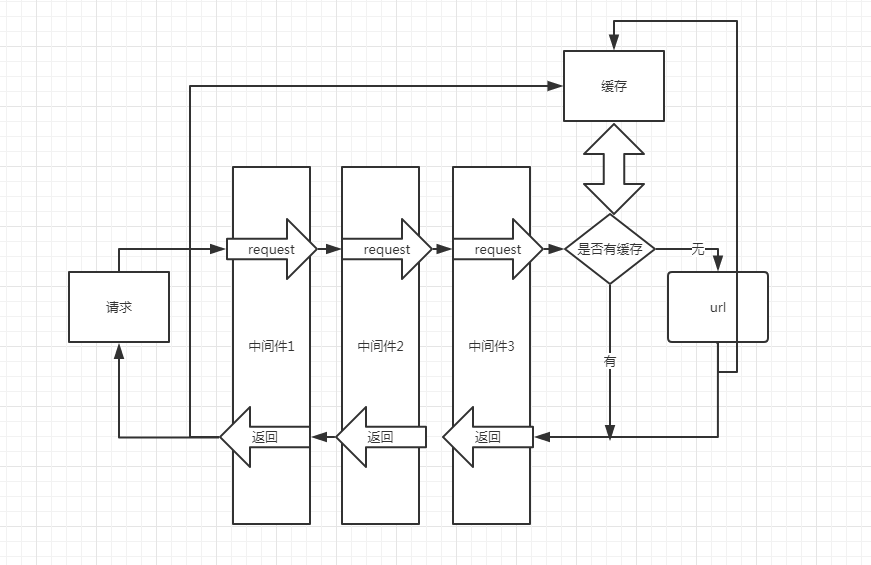缓存实例
由于Django是动态网站,所有每次请求均会去数据进行相应的操作,当程序访问量大时,耗时必然会更加明显,最简单解决方式是使用:缓存,缓存将一个某个views的返回值保存至内存或者memcache中,
5分钟内再有人来访问时,则不再去执行view中的操作,而是直接从内存或者Redis中之前缓存的内容拿到,并返回。
5种配置
(1)、开发调试版本:

1 # 此为开始调试用,实际内部不做任何操作 2 # 配置: 3 CACHES = { 4 'default': { 5 'BACKEND': 'django.core.cache.backends.dummy.DummyCache', # 引擎 6 'TIMEOUT': 300, # 缓存超时时间(默认300,None表示永不过期,0表示立即过期) 7 'OPTIONS':{ 8 'MAX_ENTRIES': 300, # 最大缓存个数(默认300) 9 'CULL_FREQUENCY': 3, # 缓存到达最大个数之后,剔除缓存个数的比例,即:1/CULL_FREQUENCY(默认3) 10 }, 11 'KEY_PREFIX': '', # 缓存key的前缀(默认空) 12 'VERSION': 1, # 缓存key的版本(默认1) 13 'KEY_FUNCTION' 函数名 # 生成key的函数(默认函数会生成为:【前缀:版本:key】) 14 } 15 } 16 17 18 # 自定义key 19 def default_key_func(key, key_prefix, version): 20 """ 21 Default function to generate keys. 22 23 Constructs the key used by all other methods. By default it prepends 24 the `key_prefix'. KEY_FUNCTION can be used to specify an alternate 25 function with custom key making behavior. 26 """ 27 return '%s:%s:%s' % (key_prefix, version, key) 28 29 def get_key_func(key_func): 30 """ 31 Function to decide which key function to use. 32 33 Defaults to ``default_key_func``. 34 """ 35 if key_func is not None: 36 if callable(key_func): 37 return key_func 38 else: 39 return import_string(key_func) 40 return default_key_func
(2)、内存版本

# 此缓存将内容保存至内存的变量中 # 配置: CACHES = { 'default': { 'BACKEND': 'django.core.cache.backends.locmem.LocMemCache', 'LOCATION': 'unique-snowflake', } } # 注:其他配置同开发调试版本
(3)、文件

# 此缓存将内容保存至文件 # 配置: CACHES = { 'default': { 'BACKEND': 'django.core.cache.backends.filebased.FileBasedCache', 'LOCATION': '/var/tmp/django_cache', } } # 注:其他配置同开发调试版本
(4)、数据库

# 此缓存将内容保存至数据库 # 配置: CACHES = { 'default': { 'BACKEND': 'django.core.cache.backends.db.DatabaseCache', 'LOCATION': 'my_cache_table', # 数据库表 } } # 注:执行创建表命令 python manage.py createcachetable
(5)、Memcache缓存(python-memcached模块)

# 此缓存使用python-memcached模块连接memcache CACHES = { 'default': { 'BACKEND': 'django.core.cache.backends.memcached.MemcachedCache', 'LOCATION': '127.0.0.1:11211', } } CACHES = { 'default': { 'BACKEND': 'django.core.cache.backends.memcached.MemcachedCache', 'LOCATION': 'unix:/tmp/memcached.sock', } } CACHES = { 'default': { 'BACKEND': 'django.core.cache.backends.memcached.MemcachedCache', 'LOCATION': [ '172.19.26.240:11211', '172.19.26.242:11211', ] } }
(6)、Memcache缓存(pylibmc模块)

# 此缓存使用pylibmc模块连接memcache CACHES = { 'default': { 'BACKEND': 'django.core.cache.backends.memcached.PyLibMCCache', 'LOCATION': '127.0.0.1:11211', } } CACHES = { 'default': { 'BACKEND': 'django.core.cache.backends.memcached.PyLibMCCache', 'LOCATION': '/tmp/memcached.sock', } } CACHES = { 'default': { 'BACKEND': 'django.core.cache.backends.memcached.PyLibMCCache', 'LOCATION': [ '172.19.26.240:11211', '172.19.26.242:11211', ] } }
(7)Redis缓存(依赖:pip3 install django-redis)

CACHES = { "default": { "BACKEND": "django_redis.cache.RedisCache", "LOCATION": "redis://127.0.0.1:6379", "OPTIONS": { "CLIENT_CLASS": "django_redis.client.DefaultClient", "CONNECTION_POOL_KWARGS": {"max_connections": 100} # "PASSWORD": "密码", } } }

from django_redis import get_redis_connection conn = get_redis_connection("default")
3种应用:
全局

1 使用中间件,经过一系列的认证等操作,如果内容在缓存中存在,则使用FetchFromCacheMiddleware获取内容并返回给用户,当返回给用户之前,判断缓存中是否已经存在,如果不存在则UpdateCacheMiddleware会将缓存保存至缓存,从而实现全站缓存 2 3 MIDDLEWARE = [ 4 'django.middleware.cache.UpdateCacheMiddleware', 5 # 其他中间件... 6 'django.middleware.cache.FetchFromCacheMiddleware', 7 ] 8 9 CACHE_MIDDLEWARE_ALIAS = "" 10 CACHE_MIDDLEWARE_SECONDS = "" 11 CACHE_MIDDLEWARE_KEY_PREFIX = ""
视图函数

方式一: from django.views.decorators.cache import cache_page @cache_page(60 * 15) def my_view(request): ... 方式二: from django.views.decorators.cache import cache_page urlpatterns = [ url(r'^foo/([0-9]{1,2})/$', cache_page(60 * 15)(my_view)), ]
模板

1 a. 引入TemplateTag 2 3 {% load cache %} 4 5 b. 使用缓存 6 7 {% cache 5000 缓存key %} 8 缓存内容 9 {% endcache %}




